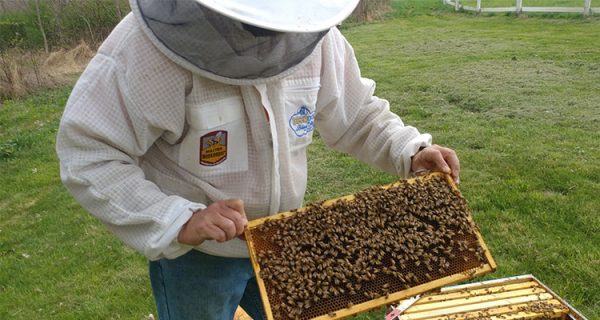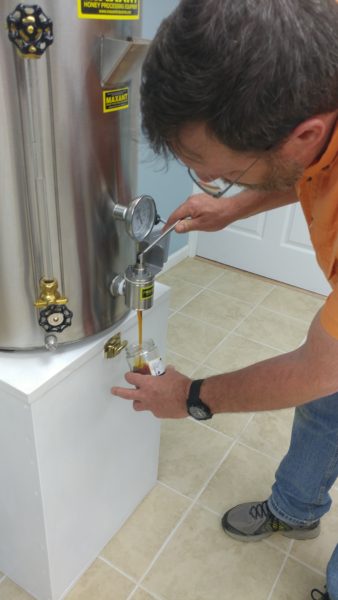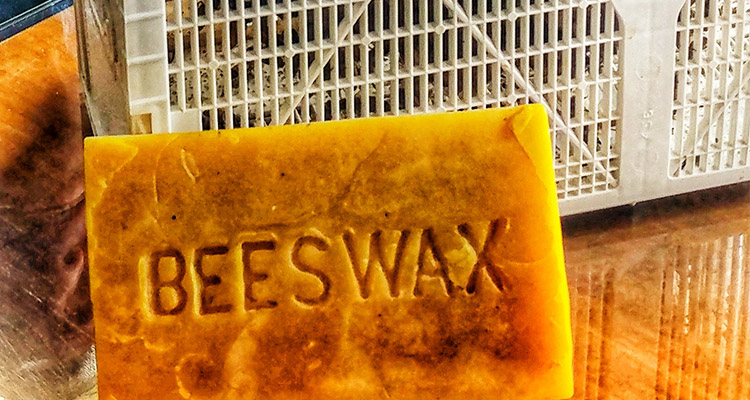Standing beside John Welty’s hive, cradling the little worker bee who died when she stung my protective suit, I feel as though I’ve just committed ecological sin. Honeybees are in trouble, after all. It’s all over the news, all over social media: they’re dying in record numbers.
There’s a quote attributed to Einstein: “If the honeybee disappeared off the face of the earth, man would have only four years left to live.” Welty and fellow master beekeeper Steve Roth beg to differ and assured me that hype has overshadowed reality. Not only did Einstein never utter these words (he was a physicist, not an entomologist), but they also aren’t true.
While beekeepers travel all around the outer edges of the country with their hives, following a yearly pollination schedule, their services aren’t needed in America’s heartland. Honeybees don’t work in the interior of our country, in the “bread basket” region. They don’t do corn, wheat or grains. Moreover, we have a plethora of pollinators at work all over the planet. There are over 3,700 species of native bees in North America (honeybees are not native). Bumblebees pollinate. Mason bees pollinate. Sweat bees. And then you’ve got butterflies, moths, beetles and even mosquitos.

“Honeybees are not a huge population of pollinators,” Welty tells me. “Some plants aren’t built for pollination by honeybees. The main thing that honeybees pollinate are what I call specialty items. A lot of the fruits. If bees went away, the earth would not go away. We’d change our diet. It’s just the fun stuff we eat. A lot of the apples we eat. We can survive without those. We wouldn’t be happy, but we’d survive. Probably 70 percent of the specialty foods we eat are pollinated by honeybees. But probably 20 percent of everything pollinated is honeybees.”
That said, it’s true that wild honeybees are threatened. You may have read about the pesticides known as neonicotinoids — they get a lot of press because they cause problems with the bees’ inner compass and the workers cannot find their way home. The real problem actually comes from the varroa mite, a parasite accidentally introduced in Florida in 1983. The mites attack both the adult bees and the brood, weakening the colony. Once infected, wild honeybees will eventually succumb, but not before casting off several swarms.
However, in managed hives, beekeepers know what they’re up against, so preparation and treatment are possible. The varroa mite has become part of a beekeeper’s education.
“That challenge made us better beekeepers,” Roth said. “We were better beekeepers so there was less of a loss.” He assured me that managed honeybees are thriving, and their numbers continue to climb.
“Yeah, wild bees are in trouble,” he acknowledged. “But they’re not going to die off. You can’t really keep a count of bees in the wild. You can tell the numbers of managed hives. And if a beekeeper loses a hive, he replaces the hive.”
The beekeepers are the key, here. Bees are flourishing in numbers because of beekeepers and beekeeping organizations like Tri-State Beekeepers. Beekeeping is an old pastime; it came to North America in the 1600’s when wax and honey were necessities. Tri-State Beekeepers Association aims to promote the art and science of beekeeping in Ohio, Marshall and Belmont Counties. Each spring, they teach a class. If you’re interested, this is the place to start. Students learn all aspects of beekeeping, including how to acquire hives and bees. Students also have the support of instructors both in class and once they’re out on their own. Classes begin in February and run through April.
“It’s overwhelming,” Welty says of novice beekeeping. “You need a helping hand.”
As I try to put the dead bee out of my mind, I understand the importance of mentorship. Both Roth and Welty caution against DIY beekeeping; this isn’t an art you can learn from YouTube. Welty likens it to bringing home your first child: Everything is new, and you’re scared to death you’re going to screw up.

We close up the hives, and John drives me back to his “honey house” for a lesson on honey extraction. The process is quite simple: using a knife, he removes the caps from the combs and inserts each frame into an extractor. The extractor works like a centrifuge, spinning the honey off the frames. Once it’s collected, it goes into a bottler where it stays warm until it’s poured into a jar. Honey doesn’t need to be sterilized; it has natural antibacterial properties. Welty pours me a jar of dark honey from the bottler. It’s from last September; honey gets darker as the season progresses.
Soon, you’ll find the Weltys at the farmers’ market. You’ll probably meet the Roths at Oglebayfest. In the meantime, they’ll be tending to their honeybees and teaching the art of beekeeping to a new round of students. Blossom by blossom, bee by bee, beekeepers help a species to thrive, and they keep food on our table and honey in our cupboards.
The honey I bring home doesn’t last two weeks.
(Read Part 1 of Laura’s story here.)
• Laura Jackson Roberts is a freelance writer in Wheeling, W.Va. She holds an MFA in Creative Writing from Chatham University and writes about nature and the environment. Her work has recently appeared in Brain, Child Magazine, Vandaleer, Animal, Matador Network, Defenestration, The Higgs Weldon and the Erma Bombeck humor site. Laura is the Northern Panhandle representative for West Virginia Writers, a blog editor for Literary Mama Magazine and a member of Ohio Valley Writers. She recently finished her first book of humor. Laura lives in Wheeling with her husband and their sons. Visit her online at www.laurajacksonroberts.com.


